
| KIT #: | ? |
| PRICE: | $28.00 and cheaper |
| DECALS: | usually three options |
| REVIEWER: | Tom Cleaver |
| NOTES: | Mild coversion, Lifelike Decals 48-007 “Supermarine Spitfire Mk. XVIe Part 2" |

| HISTORY |
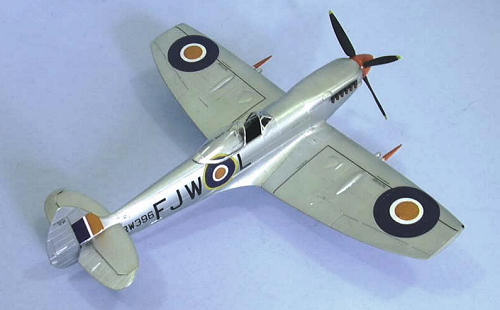 The Spitfire IX was a “stopgap” fighter based on the airframe of the Spitfire V
- which was itself a “stopgap” based on the Spitfire I airframe - to rapidly
produce a fighter capable of taking on the Focke-Wulf Fw-190 and the G-series
Bf-109, powered by the Merlin-66 series with a two-stage supercharger.
In the end, the Spitfire IX in its various iterations
was the most widely-produced version, only exceeding the Spitfire V by a few
hundred airframes.
The Spitfire IX was a “stopgap” fighter based on the airframe of the Spitfire V
- which was itself a “stopgap” based on the Spitfire I airframe - to rapidly
produce a fighter capable of taking on the Focke-Wulf Fw-190 and the G-series
Bf-109, powered by the Merlin-66 series with a two-stage supercharger.
In the end, the Spitfire IX in its various iterations
was the most widely-produced version, only exceeding the Spitfire V by a few
hundred airframes.
Given that the mighty Merlin was the engine of choice for many British combat
aircraft, as well as at least two American fighters, the limited British
production facilities were not able to keep up with demand.
Following the entry of the United States into the war,
General Motors received a license to produce the Merlin, which was assigned to
the Packard division after the American automobile industry converted to war
production.
The American-built Merlin differed from its British cousin the way American
English differs from its British cousin.
Packard modified the design to utilize American
dimensions rather than Imperial measurements, to adapt the engine to American
production demands.
The result was a Merlin that was similar enough to the
original that it could power an airframe designed for it without difficulty, but
that could not be maintained interchangeably with spare parts and tools.
When the British decided to use the American Merlin in the Spitfire, the result
was given a different mark number to distinguish it - Mk. XVI.
The Spitfire XVI started to appear in the last Spring of
1944, and RAF squadrons quickly realized that these airplanes could not be
assigned willy-nilly to a unit equipped w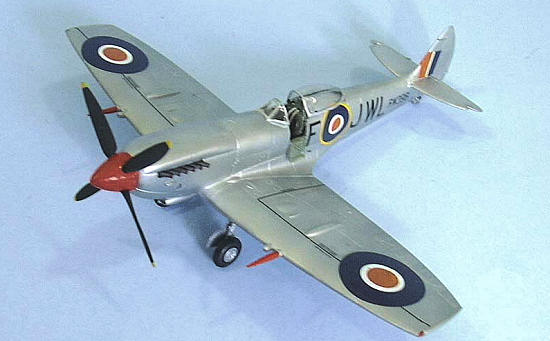 ith
Spitfire IXs, due to the problem of the need for different spare parts and
tools.
Thus, by the summer of 1944, squadrons were completely re-equipped when
they received the Spitfire XVI.
As Supermarine was more and more focused on the
Griffon-powered Spitfires, the Spitfire XVI was produced by the Castle Bromwich
“shadow” factory and also by General Aircraft.
By late 1944, the Spitfire XVI formed the majority of
Merlin-powered Spitfire aircraft assigned to RAF tactical fighter-bomber
squadrons in 2TAF.
ith
Spitfire IXs, due to the problem of the need for different spare parts and
tools.
Thus, by the summer of 1944, squadrons were completely re-equipped when
they received the Spitfire XVI.
As Supermarine was more and more focused on the
Griffon-powered Spitfires, the Spitfire XVI was produced by the Castle Bromwich
“shadow” factory and also by General Aircraft.
By late 1944, the Spitfire XVI formed the majority of
Merlin-powered Spitfire aircraft assigned to RAF tactical fighter-bomber
squadrons in 2TAF.
Following the end of the war, the Spitfire XVI appeared in various European air
forces as their squadrons that had operated with the RAF during the war were
repatriated.
Thus, the Spitfire XVI was ultimately flown by the Czech, Belgian
and Norwegian Air Forces.
The airplanes also continued in RAF service, equipping
squadrons of the Royal Auxiliary Air Force into the early 1950s.
While other “American” aircraft left British service
quickly due to the need for the British to pay for any Lend-Lease airplane that
was kept in service, the American Merlin engines had not been provided under
Lend-Lease but rather as “royalty payments” for the licensing rights.
Spitfire XVIs were also used as “hacks” by various RAF units, where former wartime fighter pilots would keep their hand in, such as the well-known Spitfire XVI flown by the Central Gunnery Establishment.
| THE KIT |
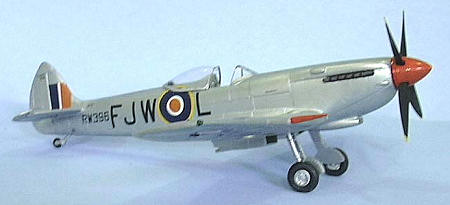 The Hasegawa Spitfire IX series first appeared in 2001, and quickly acquired the
reputation of being “wrong” for the layout of the fuselage, which is too long in
the nose and too short in the rear fuselage.
I personally don’t blame Hasegawa for this, since the
drawings they used were created by a Japanese researcher who is well-respected
there; these drawings can be found in the AeroFile publication for the Spitfire
IX.
The kit is otherwise excellent, providing a very good cockpit.
Many modelers now use the Aeroclub conversion, which
provides an injection-molded fuselage that is correctly proportioned and is a
“drop fit” conversion of the Hasegawa kit.
The Hasegawa Spitfire IX series first appeared in 2001, and quickly acquired the
reputation of being “wrong” for the layout of the fuselage, which is too long in
the nose and too short in the rear fuselage.
I personally don’t blame Hasegawa for this, since the
drawings they used were created by a Japanese researcher who is well-respected
there; these drawings can be found in the AeroFile publication for the Spitfire
IX.
The kit is otherwise excellent, providing a very good cockpit.
Many modelers now use the Aeroclub conversion, which
provides an injection-molded fuselage that is correctly proportioned and is a
“drop fit” conversion of the Hasegawa kit.
The basic kit has been re-released over the years as a Spitfire XII, a Spitfire VIII and a Spitfire XVI with differing modifications to wingtips and such, and different decals.
| CONSTRUCTION |
I
have always thought that the well-known Spitfire XVIe “F-JWL” would make up as
an interesting model, so when I received the Lifelike Decals sheet 48-007 “Supermarine
Spitfire Mk. XVIe Part 2," which includes this airplane, I was interested in
doing a 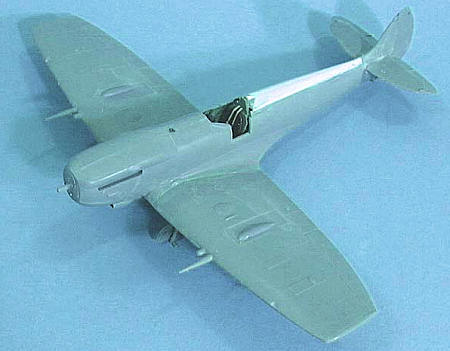 model.
The sheet is for the ICM Spitfire XVIe, which has been
long out of production with consequent reduced availability (this will hopefully
change now that ICM is back in business).
Being unable to get the right kit, but being interested
in doing the model, I remained frustrated until the local hobbyshop started
selling off the collection of a recently-deceased “serious modeler/kit
collector.”
Since there were several of these Hasegawa kits on offer at
$18.00 (a real bargain nowadays) I decided to bit the bullet and put up with the
“wrong” fuselage.
model.
The sheet is for the ICM Spitfire XVIe, which has been
long out of production with consequent reduced availability (this will hopefully
change now that ICM is back in business).
Being unable to get the right kit, but being interested
in doing the model, I remained frustrated until the local hobbyshop started
selling off the collection of a recently-deceased “serious modeler/kit
collector.”
Since there were several of these Hasegawa kits on offer at
$18.00 (a real bargain nowadays) I decided to bit the bullet and put up with the
“wrong” fuselage.
The conversion is easy.
I cut off the upper part of the rear fuselage behind the
cockpit, then assembled the fuselage per instructions.
I then glued Evergreen sheet in place, then sanded it to
shape, and then scribed in the panel lines.
For anyone contemplating a scratchbuilt conversion
project, doing a Spitfire like this is easy.
I also used the Squadron/Falcon Spitfire bubble canopy,
which is the proper shape for this canopy (only the Academy Spitfire XIVe kit
has this canopy right in the box).
I
also used Eduard photo-etch seatbelts for the cockpit.
| COLORS & MARKINGS |
Painting:
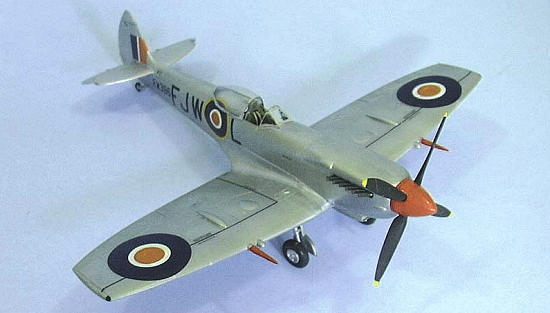 I
gave the model an overall coat of Tamiya “Flat Aluminum,” then masked off the
fabric control surfaces, and gave the model a final coat of Talon “Aluminum,”
which looked very much like the Aluminum lacquer used when I gave the model a
coat of Testor’s Model Master Clear coat.
The spinner and the cannon fairings were painted with
Xtracrylix “RAF Red”
I
gave the model an overall coat of Tamiya “Flat Aluminum,” then masked off the
fabric control surfaces, and gave the model a final coat of Talon “Aluminum,”
which looked very much like the Aluminum lacquer used when I gave the model a
coat of Testor’s Model Master Clear coat.
The spinner and the cannon fairings were painted with
Xtracrylix “RAF Red”
Decals:
The Lifelike decals went on without a glitch.
I do think that the “brick red” of the national insignia
might be a bit bright, but in the specific instance an argument could be made
that it was faded.
In any case, the decals look great when they are finally
set, which they do without problem under a coat of Micro-Sol.
| FINAL CONSTRUCTION |
I
attached the landing gear, the pitot tube, prop and canopy
| CONCLUSIONS |
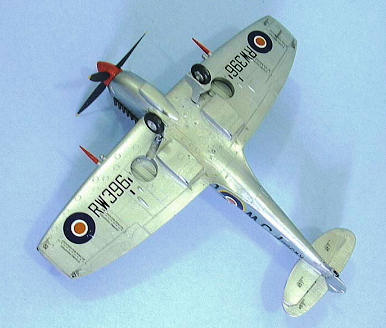 Hemingway’s comment about cats (“Having one cat leads to another”) also applies
to Spitfires.
I am sure that when ICM re-releases their Spitfire XVIe kit that
I will do at least one more of these nice markings found on the two Lifelike
Decals sheets.
Hemingway’s comment about cats (“Having one cat leads to another”) also applies
to Spitfires.
I am sure that when ICM re-releases their Spitfire XVIe kit that
I will do at least one more of these nice markings found on the two Lifelike
Decals sheets.
Review Kit courtesy of my wallet.
Decals courtesy of Keishiro Nagao at Lifelike Decals.
Get yours direct at
http://www16.ocn.ne.jp/~lifelike/
If you would like your product reviewed fairly and quickly, please contact me or see other details in the Note to Contributors.